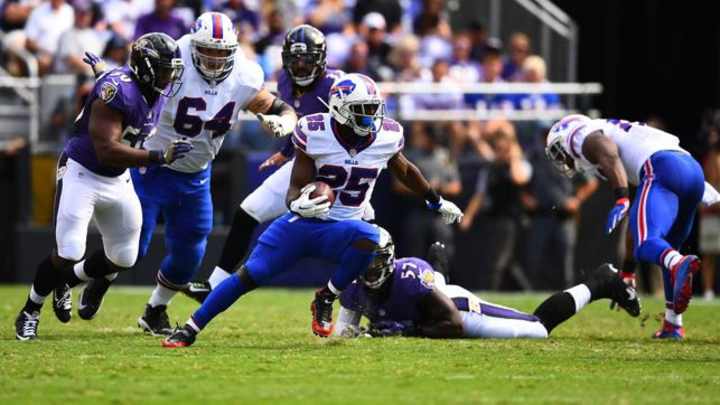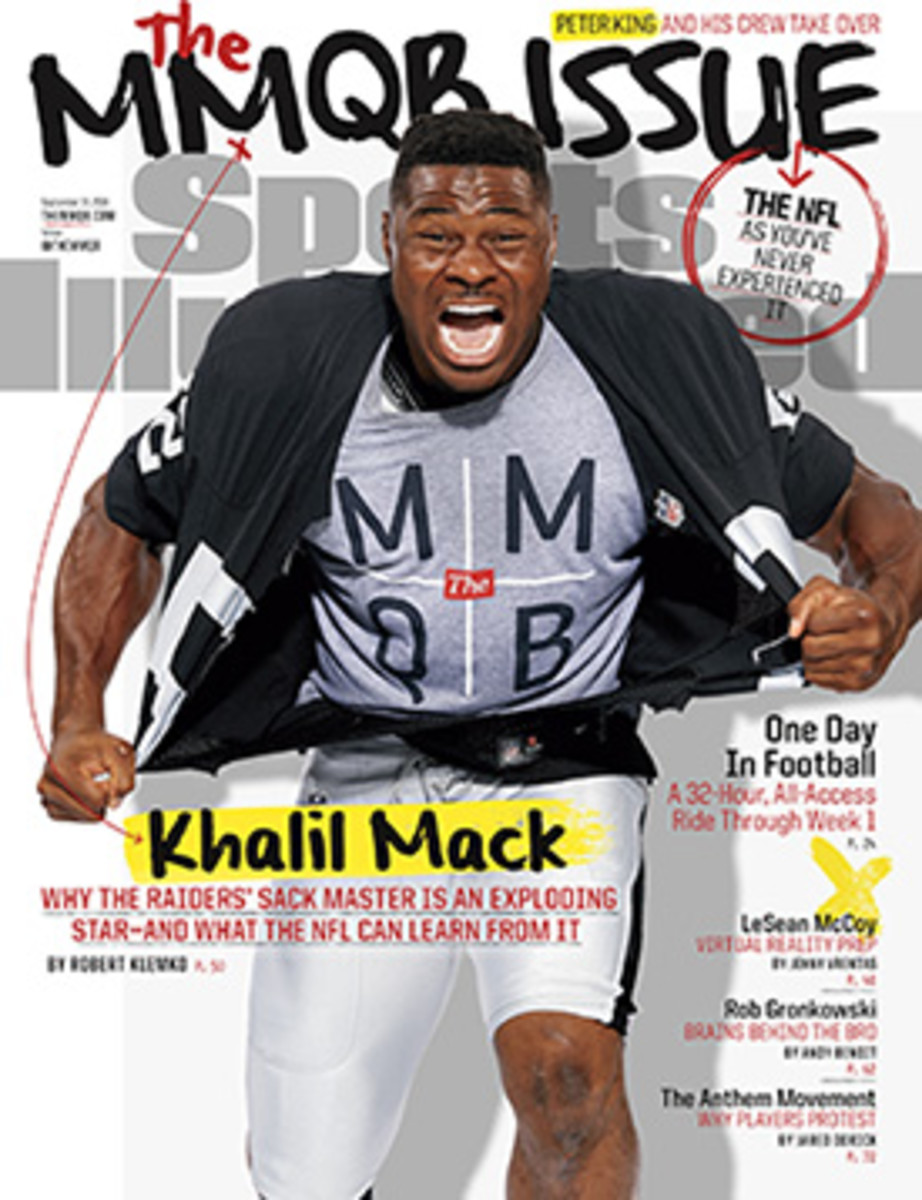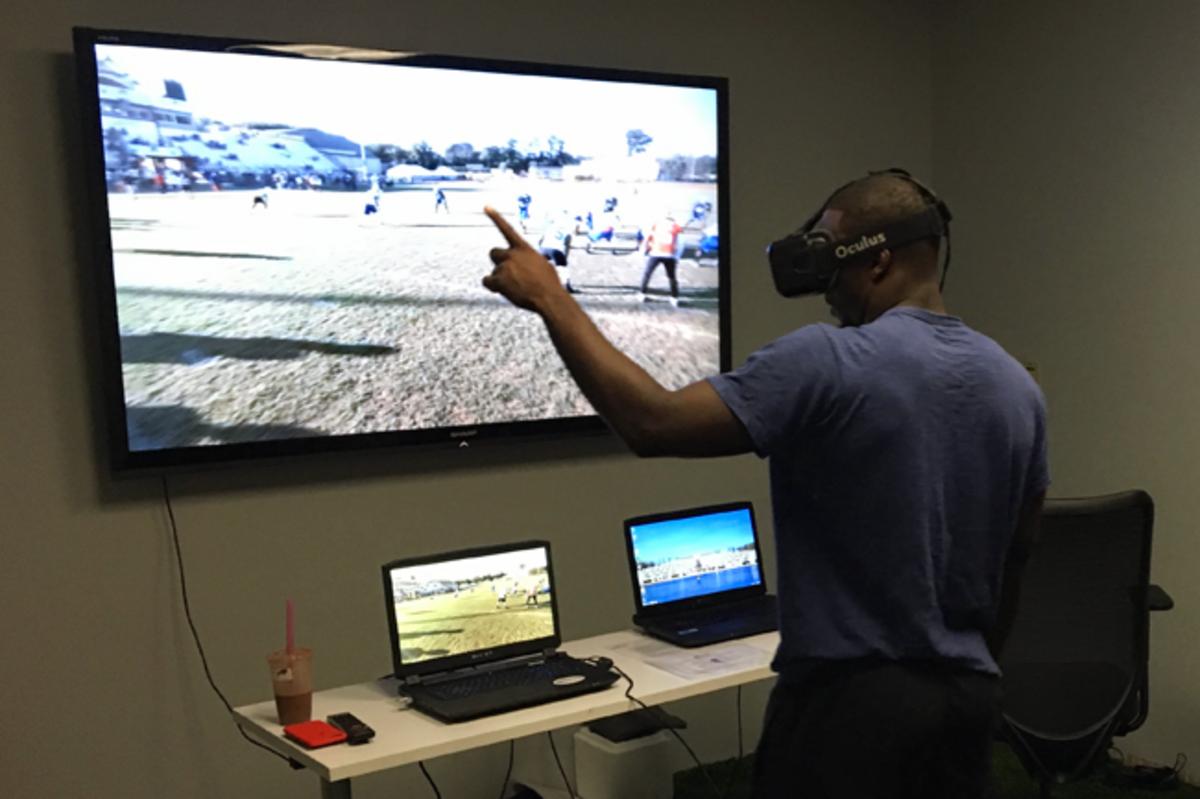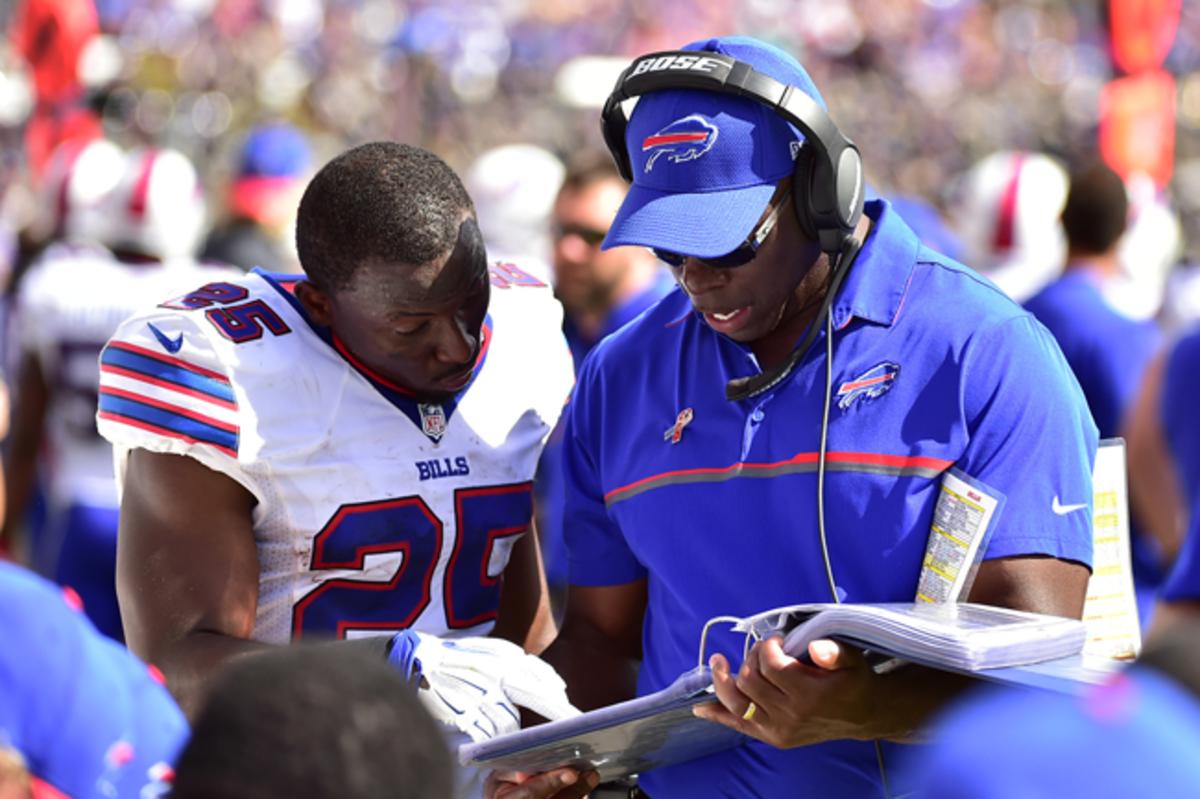LeSean McCoy’s New Reality


Editor’s Note: Peter King and the staff of The MMQB took over this week’s issue of Sports Illustrated magazine. In it, you’ll read the kind of feature stories that you’ve come to expect from The MMQB, plus an all-access behind-the-scenes look at one day in the life of the NFL, from inside the Texans’ team meeting on the night before the season opener to the Patriots’ celebrations at the end of their surprise win in Arizona, and much more. Pick up the magazine on newsstands, or subscribe here.
A few minutes after 8 a.m. LeSean McCoy walks into a windowless room on the first floor of the Bills’ headquarters in Orchard Park, N.Y. He puts down his Louis Vuitton backpack and his chocolate protein shake and straps on a virtual-reality headset to stare down an NFL defense. In the 13-by-16-foot room, which is lined with FieldTurf, the eighth-year running back stands over a hash mark and peers through the goggles at a wall-mounted TV. His position coach, Anthony Lynn, cues up a running play from practice.
“Oh, this is crazy!” McCoy says with a giggle. “Ha! Jim Brown would have loved to have this.”
Reps, even mental ones, come at a premium 12 days before the season opener. In a 25-minute session designed to strengthen the mind’s eye, Lynn applies constant pressure in the form of timed quizzes. Whether running the ball, staying in to block or releasing on a pass route, a back has about seven seconds between the breaking of the huddle and the snap to line up and pinpoint his assignment. That’s how long Lynn gives McCoy to make his reads on this Tuesday morning. In between those bursts, Lynn teaches.
“Rewind that,” he says, breaking down a pass play. “Now, if that was an option route, oh, my goodness! You’d kill them on the inside move right there.”
McCoy takes another look, reciting the defensive front, the protection call, the coverage and how he should run his route. “We are running option routes,” Lynn says of the Week 1 game plan for the Ravens, “and I have all these coverage looks on tape for you. Get you some mental visuals.”
“Nice!” McCoy says, adjusting the mask. “Can I get this at home, too?”
* * *

This isn’t Jim Brown’s NFL, and it hasn’t been for a long time. Virtual reality aside, today’s game is an aerial spectacle; a league record for passing yards has been established each year since 2009. Backs are so devalued that only three were taken in the first round over the past four NFL drafts. (Ten were chosen over the previous four.)
The new way of thinking: The guys who run the ball are interchangeable and -replaceable—even the veterans. Over the 2013 and ’14 seasons DeMarco Murray led the NFL with 2,966 rushing yards, and LeSean McCoy finished second with 2,926 (each also won a single-season rushing title), but going into last season, the Cowboys let Murray walk in free agency, and McCoy was traded to Buffalo for a linebacker who lasted only a year in Philadelphia. “People think you just tote the rock and go,” Bills coach Rex Ryan says, pantomiming a handoff. “That couldn’t be further from the truth.”
Few coaches have been as loyal to the ground game. During Ryan’s seven years as a head coach—six with the Jets and one with the Bills, all with Lynn overseeing the running backs room—his teams have rushed for the most cumulative yards in the league. Buffalo was one of four teams that ran more than they threw last season (509:465), and its 152.0 yards per game and 4.8 yards per carry were league highs. Yet the job of a running back is misunderstood even in Buffalo’s locker room.
Defensive players occasionally mock the backs by asking, What, exactly, do you do in the film room anyway? Rookie Jonathan Williams, a fifth-round pick out of Arkansas, recently overheard one of the athletic trainers saying he wished he could be a running back, because it seemed so simple. “I told him, ‘No!’ ” Williams says, still stunned. “We have to know a lot of stuff!”
The Bills’ game plan against the Ravens on Sunday contained nearly 50 running plays. Each came with an alignment (where the back lines up), designated footwork (there are at least a dozen varieties) and an aim point (what to run toward). As the back approaches the line of scrimmage, he makes his primary read off one defender. The best backs can almost simultaneously read a second defender—just like top quarterbacks can read two safeties at once—and sense where daylight exists amid the chaos of violent collisions. Each play also has something called a “big alert,” a presnap read that signals a favorable matchup for the back to seize. Something as simple as taking the wrong first step can muck up the timing of a carefully orchestrated play.
“People think you just tote the rock and go,” Rex Ryan says. “That couldn’t be further from the truth.”
Just before halftime on Sunday the Bills faced fourth-and-goal from the one and gambled. Instead of kicking a field goal, they called for 91 Lead, a running play designed to have the fullback take on a linebacker and clear the way. The tailback usually lines up seven yards deep, but when every inch counts, he cheats up so his toes are six yards from the line of scrimmage. McCoy isn’t the ideal type of back for this situation because of his size (5’ 11”, 208 pounds) and his running style (elusive rather bruising), but he refused to come off the field. “When a guy waves me off,” Lynn says, “you better get in for the score.”
Before the snap McCoy read the defensive front and determined there’d be no room between the left guard and the center because the Ravens were plugging the gap. So he adjusted and, as he had studied, ran around the left tackle and surged into the end zone for the Bills’ only score in a 13–7 loss.
McCoy, 28, admits to having relied on his physical gifts to beat defenders for most of his career. But after being dogged by a hamstring injury last fall, he’s learning to use his mind more. “Coach Lynn has taught me, so when I go out there, it is not just natural instinct,” McCoy says. “It’s actual knowledge. I have seen this before; I know where to go. That’s the difference.”
* * *

The line on Anthony Lynn’s NFL career: six seasons, 28 carries, 177 yards, zero touchdowns, zero fumbles and two Super Bowl rings. The undrafted back was a teammate of Terrell Davis’s when the Broncos won back-to-back Super Bowls in the late 1990s. His biggest takeaway from watching Davis become, in ’98, the fourth back (there are now seven) to rush for at least 2,000 yards: “Scheme only gets you so many yards,” Lynn says. “The special backs get what’s blocked and then some.”
Back then Mike Shanahan’s zone-blocking running scheme thrived off a few basic concepts. Now the Bills’ high-volume offense, under coordinator Greg Roman, mixes everything from zone to gap to trap to zone-read to Wildcat. But the biggest difference since Lynn left the field has had to do with the unglamorous part of a running back’s job. When Lynn retired, in 2000, backs were responsible for reading one or two defenders when blocking on pass plays. Because defenses have diversified in lockstep with offenses, and because blitzes are better disguised than ever, backs must often scan up to six defenders to identify and block the most dangerous potential rusher.
The Bills had 10 protections in last week’s game plan, each requiring adjustments at the line; the backs had to study about 30 base and nickel pressures of the Ravens’ defense. By kickoff, Lynn had held 10 mini-meetings to go over these protections alone, but the Ravens (two sacks, six QB hits) cooked up some new surprises.
Whether the ball is on the ground or in the air, Lynn’s primary goal is to find ways to slow down an impossibly fast game for his players. To help one of his younger backs, Mike Gillislee, Lynn asked third-string quarterback Cardale Jones to record audio of the Week 1 play calls so Gillislee could visualize responding (in seven-second increments, of course). Lynn also employs a method he calls “deep practice”—making the game harder during the week so it seems easier on Sundays. He has his guys do read-and-reaction drills from six yards deep instead of seven to give them less time to make a decision. During a recent special-teams period Lynn put McCoy behind an “offensive line” of five garbage cans and rattled off Baltimore pressures at lightning speed, baiting McCoy into making mistakes as he made the protection calls. “After a while, they look at me like, Go to hell, because they are so confident in what they know,” Lynn says. “That’s what you want.”
There’s also homework. Early in the prep week Lynn hands out packets of worksheets, with one page for each play in the game plan. For all running plays, the backs write in the formation, the defensive front and how the concept is blocked. They must draw one dot for the primary read and two dots for the “second-vision” read, and they must highlight the big alert, if there is one.
Lynn, a running backs coach in the NFL since 2003, didn’t always emphasize blocking schemes this much. That changed in ’10, when he and Ryan were with the Jets. Future Hall of Famer LaDainian Tomlinson told Lynn that learning how every run is blocked up front made him a better ballcarrier. “My game went to the next level when I learned what everyone on offense was doing,” Tomlinson says. “You can be more patient and have time to set up the defense.”
The day before every game Bills running backs have to turn in a weekly Player Film Criteria Sheet. It’s a series of 21 questions about the opposing defense (broken down into six categories) that can be completed only by watching film. Sample questions:
• What are their primary fronts?
• When they’re in 8 man spacing, who is the 8th defender in the box? And how are you going to beat him?
• How will your defender try and rush you? How will you stop this?
• What is your biggest advantage in this game? How will you maximize it?
Career days are never guaranteed—the Bills mustered only 65 yards on 24 carries against a punishing Ravens D—but this holds true every week: “It’s a QB‑dominated league,” McCoy says, “but nothing gets done without the RBs.”
Question? Comment? Let us know at talkback@themmqb.com
